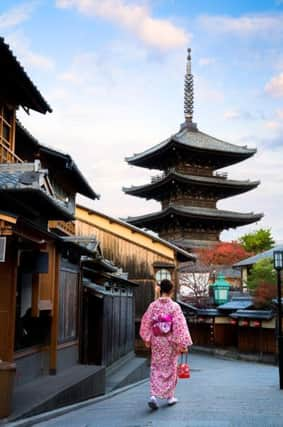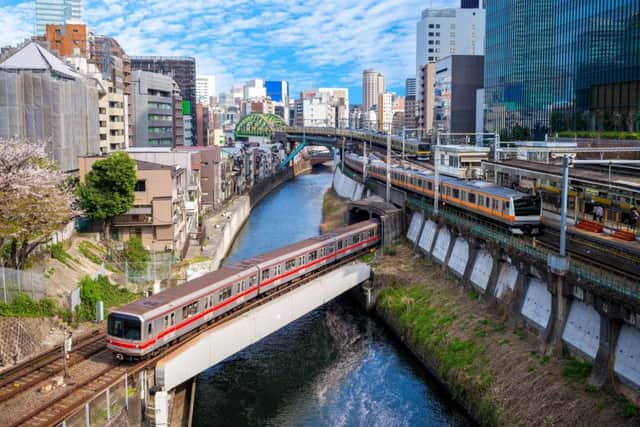Travel: Japan by plane, train and automobile


It was high summer when I conquered Japan. A three-week tour including three of the four main islands and ten forms of transport. Just to get to Kawana golf resort, 100km from Tokyo, took three trains and a taxi… after a 12 hour flight.
I didn’t share my doubts about the ordeal ahead with the flight attendants on my ANA flight to Tokyo, just luxuriated in sushi, sashimi, sake and movies, but never have I felt so reluctant to leave a business class womb.
Advertisement
Hide AdAdvertisement
Hide AdAnd yet, after running the gauntlet of Shinagawa on the stopping service into central Tokyo with the help of a cheery student, I arrived with relative ease at Kawana, a time-warped hotel on the Izu Peninsula. Built by the Anglophile Baron Kishichiro Okura, the late 1920s classic stands on a rise overlooking lawns sweeping down to Pacific cliffs. He built a golf course at the same time, the Oshima, but it took a visit from Liverpudlian, Charles Alison, partner to Alister MacKenzie and Harry Colt, to convince him that he could do better. The result is the Fuji Course, opened in 1936, rated second in Japan. It’s named for the iconic snowcapped mountain seen from the 11th fairway. Driving towards the green backed by a lighthouse shaped like a tee peg was a standout moment and the drama increased on the final stretch from the cliff rim at the 15th.


This is a hilly caddy course, with short muscular girls cart-hauling two sets of clubs, but robot buggies transport guests to steeper tees. Get in, switch on and have faith. Fuji is strictly for hotel guests, making it endearingly empty, while Oshima is open to non-residents.
It’s absolutely not necessary to play golf to enjoy the spacious hotel, but only 34 of its 100 rooms are non-smoking so reserve in advance. Honeymooners can make like Joe DiMaggio and Marilyn Monroe who took theirs here in 1954.
Compete outdoors on two of Japan’s three grass tennis courts and indoors in the billiard and mahjong rooms. The Pacific is not for swimming at this rocky point, but it’s full of dorado, sea bream and sea bass that end up as prime sashimi in the hotel restaurants. The cosiest is Inakaya, a 300-year-old thatched cottage forming the centrepiece of a secret garden. Watch the chef deftly prepare tempura for a maximum of 32.
And then it was time to move on. I felt like a veteran as I negotiated the return trains to Haneda (Tokyo International Airport) to take my ANA domestic flight to Sapporo, Japan’s fifth largest city, on the northern Japanese island of Hokkaido. My next mission was to deliver new socks to former champion steeplechase jockey, Richard Dunwoody, as he neared the end of his epic 2,000 mile walk in aid of Sarcoma UK. Starting at Cape Sata on the south of Kyushu three months earlier, he was heading for Cape Soya on the north of Hokkaido.


I took the wheel of my rental car with caution. On the plus side, the Japanese drive on the left and the main towns are signed in Roman characters. Even so, satnav is the lifeline to arrival. But the second largest of the four islands, is by far the least populated – and so the ideal place to start driving.
After three hours, the road straightened due north along the coast. Howling wind and horizontal rain ripped over wasteland, black beaches to the left, uncultivated greenery to the right. “Rather him than me,” I thought, turning up the heater. In Enbetsu, a very fit person in a blue anorak stepped out of a 7-Eleven store. It was Richard. After a sandwich, an ice cream, and a coffee he was off again at a trot, 25kg pack with tent and sleeping bag on his back.
In view of the hurricane, I was glad he’d booked rooms in a minshuku, a B&B in the next village 10km up the highway. Big welcome, simple accommodation, shoes off, an affordable £20 a night. Later on, I would stay in ryokans, traditional inns that have geared up to two Michelin star cuisine, silky futons on the floor and private onsen (hot baths), but this was the real deal. Perfect.
Advertisement
Hide AdAdvertisement
Hide AdThere could be no greater contrast with Kyoto, my next stop – via bus after a flight to Osaka airport. Japan’s old imperial capital – displaced by Tokyo in 1863 – prides itself on providing all things for all travellers of which there are millions, year in, year out. They spread out nicely around 1,600 Buddhist temples and 500 Shinto shrines, but things get tight in the cherry blossom season which arrives here in late March.
Kyoto is a flat city, its centre a maze of lanes and alleys, divided by the Kamo (Duck) River. There is no excuse not to hire a bike and explore. Pedal along the Philosopher’s Walk on the 400-year old Biwa canal, built to bring fresh water from the mountains in the Shogun days. Pause at the Heian Shinto shrine where Scarlett Johansson lingered in opulent gardens in Lost In Translation. Check out Nishiki Market, where exotic seafood writhes on the slab and maestros personalise knives to the standard demanded by Imperial master swordsmith, Fujiwara Aritsugu, in the shop he opened in 1560. Weave through Gion, the best known of five geisha residential zones, and down Pontocho, the street where they showcase their skills at banquets in elite clubs.
I used a seven-day Japan rail pass for my onward journey to Fukuoka, the starting point for a gourmet weekend in western Konshu. I was meeting my stepdaughter and her colleague at Kumamoto airport and Felicity then drove us to our ryokan-style high rise beside the Mount Aso rogue caldera. She found plenty to do the next morning in the Aso Cuddly Domain, a gaudy petting zoo, while Paul and I took a helicopter tour to the heart of the volcano, zooming low over cattle grazing the magma streaked uplands and spiralling into a turquoise crater lake.
Kurokawa is a rustic village dedicated to naked bathing. For unclad westerners, not always a pretty sight, there’s no hiding place on the walk of shame through elfin teenagers, but an outdoor rock pool at 40C is a fair pay-off.
We took the car ferry to the Shimabara Peninsula, arriving in Nagasaki at dusk. The next morning we headed to the Atomic Bomb museum. As you walk in, the clock ticks as though it were 9 June, 1945. When the minute hand reaches 11.02, Fat Boy thunders down, its mushroom clouds enveloping the screens. Out of a population of 240,000, 73,884 people died and 74,909 were injured. The death toll has since stabilised at around 172,000, though there are still genetic consequences. The museum delivers a stern peace message, with the National Peace Memorial Hall offering mindful contemplation after the emotional roller coaster.
More positively, the Dutch East India Company’s 17th century merchants introduced beef to the Japanese, giving Nagasaki the ammo to challenge Kobe as the wagyu capital of the planet. So we spend our final magical evening pigging out on the mouth-watering results.
FACT FILE
ANA – All Nippon Airways: (ana.co.jp, 0808 234 6842) London Heathrow-Tokyo Haneda, return flights, economy from £823, premium economy from £1,603, business from £3,503.
Abercrombie & Kent: (abercrombieandkent.co.uk, 01242 386483) Temples, Shrines & Geishas, 10-day group holiday, from £5,795 pp.
Japan Experience (japan-experience.com, +44 20 3514 6932) Gourmet Tour, three nights, from £820 for two, including self-drive car, one night in a ryokan (with dinner) and two in hotels.